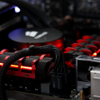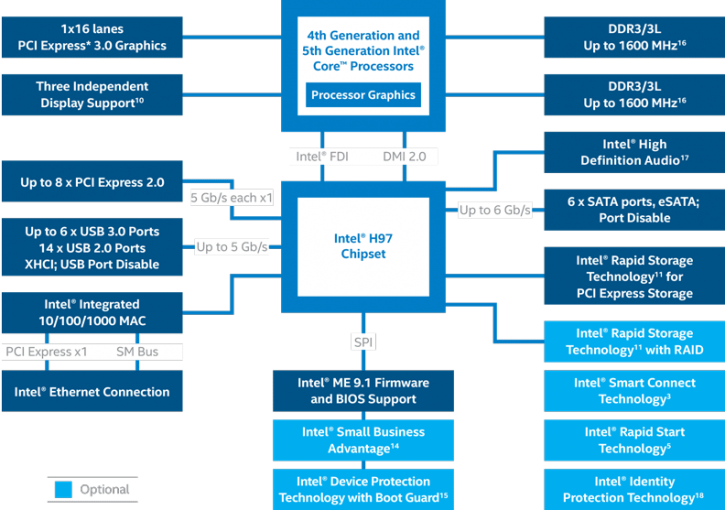The Intel Z97 PCH
PCH - The Platform Controller Hub Chipsets
Okay time for a generic / reference overview of the new Series 9 Chipset from Intel. Paired with Haswell processors come a handful of new motherboard chipsets. For end consumers like you and me the H97 chipset will be less performance targeted and comes with better support for HTPC monitor connectivity. The Z97 chipset is targeted at performance and enthusiast end users allowing much more tweaking and providing performance features.
Not a lot has changed over Z87 really, you still have six native USB 3.0 support to be found on the Z97 chipset as well as PCIe Gen 3 graphics slots. Z97 will get six SATA 6 Gbps ports.
PCI-E lanes
With PCI-E Gen 3.0 Haswell processors and platforms can feature 16 PCI-E 3.0 lanes to be used for graphics and/or other add-in PCI cards. All desktop chipsets have a single PCI-E x16 device, the Z97 chipset adds the option to use two devices at x8. The inclusion of PCI Express Gen 3 is great, but what does that boil down to? Well, simply put, PCI Express Gen 3 provides a 2X faster transfer rate than the previous generation, this delivers capabilities for next generation extreme gaming solutions. PCI Express Gen 3 has twice the available bandwidth, 32GB/s, improved efficiency and compatibility and as such it will offer better performance for current and next gen PCI Express cards. Going from PCI-E Gen 2 to Gen 3 doubles the bandwidth available to the add-on cards installed, from 500MB/s per lane to 1GB/s per lane. So a Gen 3 PCI Express x16 slot is capable of offering 16GB/s (or 128Gbit/s) of bandwidth in each direction. That results in 32GB/sec bi-directional bandwidth. Obviously the hardware you use needs to be compatible.
M2 Storage units
I am pretty excited about PCI-E M.2 storage as I have checked out what it can do. Most Z97 and newer motherboards will likely all have that cute and tiny M.2 PCIe interface. That brings small form factors add-in SSDs to our PC platform. There is an abbreviation for that, NGFF (Next Generation Form Factor). It is not just that though, SATA3 has not been amongst us for that long, but the SSDs evolved in a very fast manner, making SATA3 already a bottleneck for current generation SSDs. M.2 PCI-E links directly to your PCI-E lanes and as such, it is an interface with much more available bandwidth. At a cool 10 Gbps, the PCI-Express based M.2 has roughly 67% more bandwidth available opposed to SATA3 (6 Gbps). So that will definitely kick off a new SSD race in the upcoming months. You can expect performance in the 700 MB/sec range with these products.
USB 3.0
It should be abundantly clear by now but USB 3.0 is supported at chipset level by Intel, which should save motherboard vendors money when building Intel chipset based boards and hopefully making them overall less complicated to design. In addition to that, we will hopefully see better USB 3.0 performance. The chipset will host 6 USB 3.0 ports. Next to that 14 USB 2.0 ports are supported from the PCH.
LGA 1150 - The CPU Socket
With Sandy Bridge we moved to socket LGA 1155 and Ivy Bridge kept that socket. Haswell however sits onto socket LGA 1150. So for an upgrade to Haswell the bad news is that you'll be required to purchase a new motherboard. The good news is that the cooler pins are similar to 1155/1156 so you can re-use your cooler. So, you do not need to purchase a new CPU cooler.




